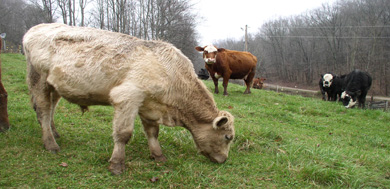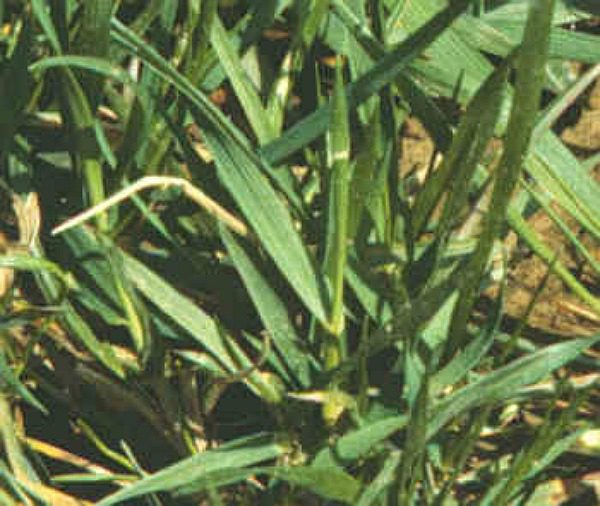MiG (Management intensive Grazing) is a method of pasture management. In this system, management of the grazing is the intensive part, hence the capitol M and small i in the acronym.
Animals generally graze with nearly the same amount of intensity regardless of the management types. The amount of proper Management is what determines how successful forage production will be in a grazing system.
Lack of management
I see a lot of pastures that I call Intensively grazed throughout the spring, summer and fall. These would be the ones where only ironweed, thistles and non-palatable weed clumps grow above that 2- to 4-inch range.
When I see this, it leads me to believe there is not a great deal of management involved in the forage production on those acres and I wonder if the livestock can consume all the forage they need to be productive as possible.
Lost profit
Are the calves or lambs gaining as much weight as they are capable of gaining? If not, it’s dollars lost!
In a typical cow-calf operation in the United States more than 80 percent of the annual feed requirement is supplied by forages and more than 90 percent of a breeding ewe’s diet is forage. This fact alone leads me to believe that properly managed forage is a key factor to being profitable in the livestock industry.
Take the fescue test
For those with a desire to manage forage growth on their farm to a higher level, fescue can be a test.
Is fescue costing you money or making you money?
Is fescue costing you money or making you money?
Many farm operators I speak with do not like fescue as forage for their livestock. However, other farm operators tell me they like to use fescue as a forage to stockpile for late fall and winter feeding.
So, how do you feel about growing fescue on your farm? What do you know about this grass? What don’t you know about the grass? What do you do with it on your farm?
Many farms I’ve seen in Ohio have fescue in either their pasture fields, their hay fields or both.
Deep-rooted perennial
Tall fescue is a deep rooted, long-lived perennial bunchgrass that is found across the eastern half of the U.S. and the Pacific Northwest, covering an estimated 25 to 40 million acres of pasture and hayland.
Tall fescue adapts well to moderately acidic and wet soils and is often more productive than other grasses when pH drops below 6 and into the 5.5 range.
Similar to other cool season grasses, tall fescue grows best when temperatures are in the 68-77 F range, meaning most growth will occur in our spring and fall seasons.
Not all rosy
Tall fescue may contain endophyte, which can cause reduced performance in livestock. Endophyte produces chemicals called alkaloids and some of them are toxic to livestock.
It has been estimated that over 90 percent of tall fescue pastures in the U.S. are infected with the fungal endophyte Neotyphodium coenophialum .
Fescue toxicosis is the product of livestock eating too much of the harmful alkaloids, but it’s usually not a lethal condition. It most often is subclinical with the only sign being poor growth or low pregnancy rates.
 Although endophyte infection of tall fescue was first recognized in the early 1940s, it was not until the late 1970s that the link was made between poor animal performance and presence of the endophyte in tall fescue
Although endophyte infection of tall fescue was first recognized in the early 1940s, it was not until the late 1970s that the link was made between poor animal performance and presence of the endophyte in tall fescue
New varieties
However, new varieties of fescue have been introduced in recent years that contain a low level of endophyte or novel endophytes that still help protect the plant from disease and insect pressure, but cause no harm or production problems in livestock like the old Kentucky 31 infected variety.
Some might say “let’s just get rid of fescue on our farm and plant other forage varieties or novel endophyte brand that does not cause toxicosis problems.” That is much easier said than done.
Stubborn seeds
Even though research has shown that fescue fungus does not move from one plant to another, nor does it move by the wind in fescue pollen, it is transferred only in seed.
The problem with eradication in pastures is, seeds in the soil may be infected, which would then germinate and the infected forage could be sustained.
Infected hay fed in a clean field could also start new infected plants, or if livestock came from grazing in a field that had infected forage in it, infected seeds could be carried in through manure to continue the problem.
So what can we do?
It may sound hopeless, but there are solutions for pastures, and hay fields are much easier to control fescue in because you can rotate crops to eliminate residual seed if you choose to do so.
The remedy to make fescue work for you rather than against you is done through diluting the stand by incorporating legumes such as red clover and other grasses.
Start with soil tests, unless you already know nutrient levels in your soils.
Bring the pH level up to 6-6.5 and be sure to have at least minimum levels of P and K available (20-25 ppm soil K and 110 ppm soil P).
Frost seeding can then be done in late winter to help establish clovers and other grasses as desired.
Numerous studies have shown that conception rates in cows and pounds of weight gained in stocker cattle have increased when red clover is added to predominantly fescue stands.
Management time
If you want to more effectively manage your pastures, especially fescue, now is the time for action in your management.
If lime is needed to bring pH levels up, get it on the fields so the lime has time to start neutralizing the soil. Lime that is surface applied can take 6-12 months to be effective.
This is just the right time to fit into that neutralizing window before frost seeding this winter.
Sample your fields
Stop by your local Extension office or Soil and Water Conservation office and get a soil probe. Most of us have equipment like this to loan out.
Take good random samples of your fields and label each properly. I always suggest a minimum of 12-15 probe plugs (and more is better!) for each field you want to sample.
Remember, the results will not be any better than the sampling technique you used to obtain the soil being tested.
If you have questions about fescue management or MiG, contact me or another member of the Ohio State University Extension Integrated Forage Management Team for help.













